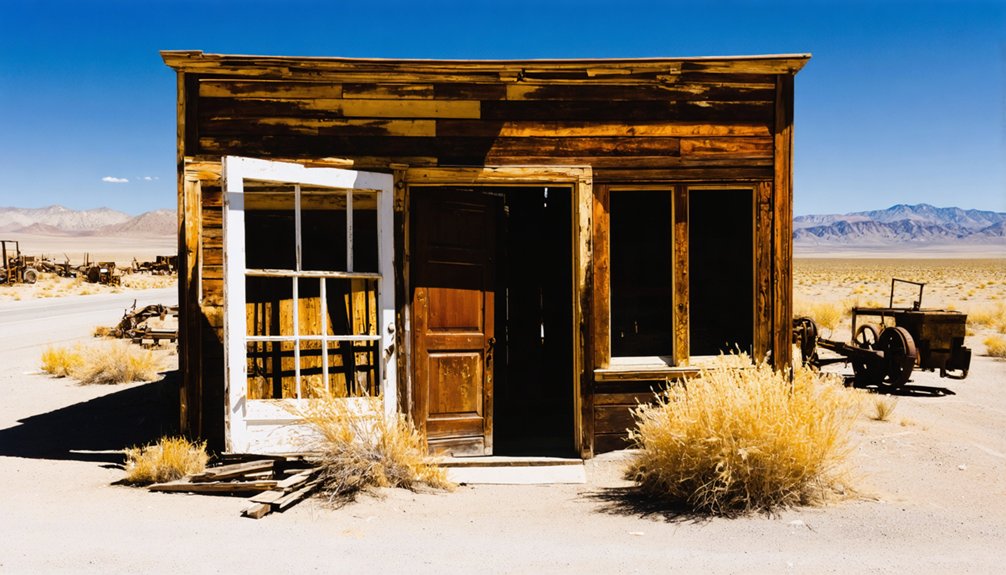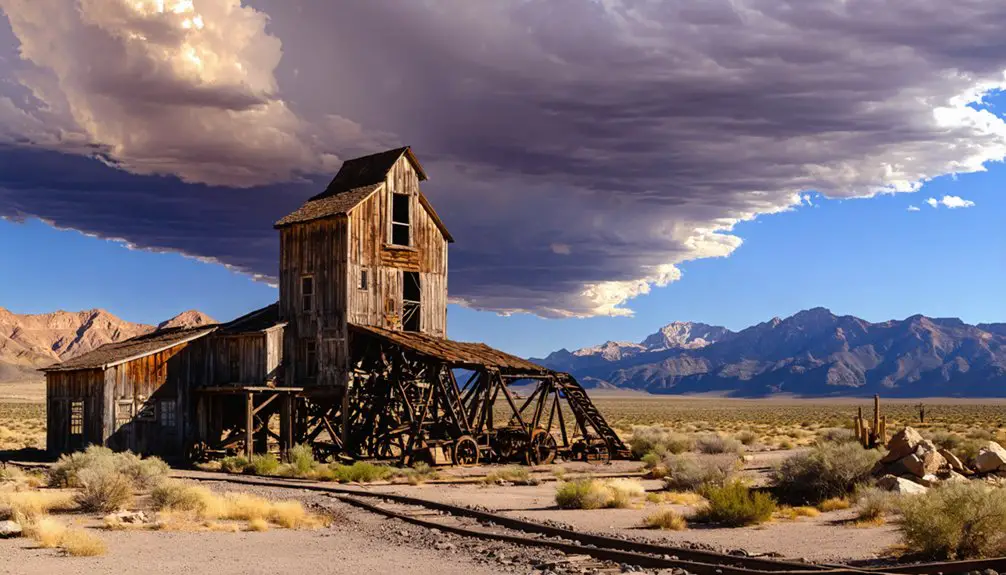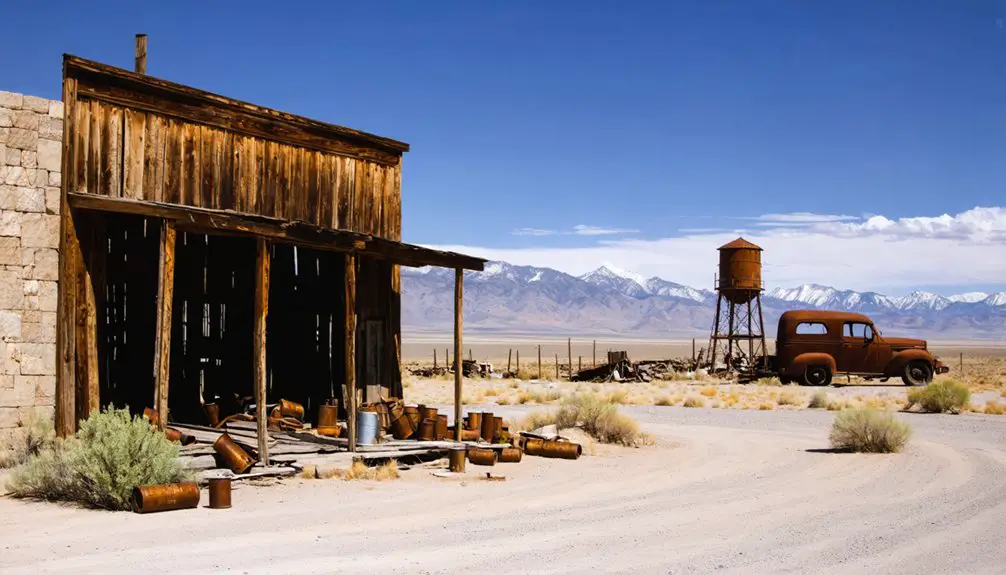You’ll find Cobre, Nevada at the historic junction where Southern Pacific Railroad met Nevada Northern Railway in 1905. This strategic hub served the copper-rich Ely region, growing from empty desert to a 60-person community with stores, hotels, and saloons. After generating millions in copper revenues through the early 1900s, Cobre declined when Southern Pacific departed in 1948. Today’s ghost town ruins tell a compelling story of Nevada’s railroad and mining heritage.
Key Takeaways
- Cobre was established in 1905 as a strategic railroad junction for copper mining operations, connecting Southern Pacific Railroad with Nevada Northern Railway.
- The town reached its peak with 60 residents and eight stores, serving as a vital hub for ore transportation from Ely’s copper mines.
- Daily life centered around railroad operations, with the town featuring a hotel, saloon, and mercantile stores for travelers and workers.
- Population declined sharply from 60 to 20 residents by 1937 due to mining accidents, harsh conditions, and economic changes.
- Cobre became a ghost town after Southern Pacific Railroad’s 1948 departure and the post office’s closure in 1956.
The Rise of a Railroad Junction Town
When the Southern Pacific Railroad and Nevada Northern Railway converged in 1905, they established Cobre as a strategic junction point in northeastern Nevada. The railroad strategy focused on connecting the copper-rich Ely region to the national rail network, with construction beginning in November 1905 and finishing by September 1906. The Nevada Northern Railway celebrated the completion with grand opening festivities on September 29, 1906.
You’ll find that Cobre’s junction significance grew rapidly as the town took shape. Within four years, it had transformed from empty land into a bustling community of 60 residents, complete with a hotel, saloon, mercantile store, and depot. By 1915, the town had established a local school building to serve the growing population.
The establishment of a post office in March 1906, transferred from nearby Toano, marked Cobre’s official recognition. This critical transportation hub enabled efficient movement of copper ore from the mines near Ely to broader markets via the Southern Pacific’s mainline.
Mining Legacy and Copper Connections
While copper mining near Ely generated $500,000 in ore value by 1902, you’ll find Cobre’s significance came from its strategic position as an essential railroad junction between the Nevada Northern and Southern Pacific lines.
You can trace how the town’s copper connections strengthened when Nevada Consolidated Copper Company expanded operations, sending millions of tons of ore through Cobre’s rail interchange toward processing facilities. The Nevada Northern Railway construction began in late 1905, connecting the two important mining locations. The town reached its peak when Western Pacific Railroad relocated its headquarters there in 1906.
The mining legacy shaped Cobre’s entire existence, from its Spanish copper-inspired name to its ultimate decline when the McGill smelter closed in 1983, ending the flow of copper ore through the once-bustling rail hub.
Copper Mining Economic Impact
Throughout Nevada’s early 1900s economic development, copper mining emerged as a transformative force that reshaped the state’s mineral industry and industrial landscape. The Anaconda Copper Mine operated continuously for 60 years until 1978, demonstrating the longevity of copper operations in the state. The Robinson Mine closure near Ely marked a significant downturn in Nevada’s copper production during the late 1990s.
You’ll find that fluctuating copper prices and evolving mining regulations influenced the sector’s growth, particularly in districts like Ely and Yerington.
The economic impact of copper mining extended far beyond the mines themselves:
- Generated over $162 million in revenue from Ely District alone between 1907-1920
- Stimulated vital infrastructure development including railroads and smelters
- Created secondary industries in equipment manufacturing and processing
- Provided sustainable employment through both direct mining and support services
Railroad Ore Transport Hub
After the Nevada Consolidated Copper Company‘s incorporation in 1905, Cobre emerged as an essential railroad junction linking eastern Nevada’s rich copper deposits to broader markets.
You’ll find this railway engineering marvel connected the 150-mile Nevada Northern Railway to Southern Pacific’s mainline, enabling efficient ore logistics across the western United States.
From Cobre, trains hauled 80-ton loads of copper ore in 40-50 car consists, traveling through challenging terrain including Robinson Canyon’s expensive 11-mile stretch.
The hub’s strategic location supported both mining operations and community development until 1941, when passenger service ended.
While ore trains continued operating, Cobre’s significance gradually diminished as mining operations evolved. The Kennecott Copper Corporation took control of operations in the 1920s, reshaping the region’s mining landscape.
Initial ore shipments in 1908 utilized Class 2-8-0 locomotives to transport the massive copper loads from the mines to processing facilities.
Underground Resource Extraction Methods
Mining operations near Cobre evolved from humble beginnings in the 1870s to sophisticated extraction methods by the early 1900s.
You’ll find that early miners relied on basic drilling and manual labor before moving to more advanced techniques. The region’s limestone deposits hosted rich copper veins that required specialized underground extraction. Empire-Nevada Copper established the first extensive mining operations in the district during the early 1900s.
Key aspects of Cobre’s underground mining included:
- Shaft sinking through multiple levels to access deep ore deposits
- Strategic drifting and stoping techniques for ideal ore recovery
- Steam-powered equipment that replaced earlier manual methods
- Contact metamorphic deposits that demanded careful extraction planning
These methods proved essential for accessing the area’s valuable copper resources, with operations lasting well into the mid-20th century. The mine site sits at an elevation of approximately 2,130 metres above sea level.
The underground workings you’d see eventually gave way to more efficient open-pit mining as technology advanced.
Life in Early 20th Century Cobre
In early 20th century Cobre, you’d find daily life revolving around the rhythms of railroad schedules, as trains brought essential supplies and connected this remote desert outpost to the wider world.
You’d witness the town’s rough-and-tumble culture through its eight mercantile stores, saloon, and hotel, which served both railroad workers and travelers passing through the junction point.
Despite the harsh desert conditions and isolation 39 miles from Wells, you’d see how the small community of about 60 residents sustained itself through railroad commerce and the regular passage of ore trains heading to and from the copper mining districts.
Daily Railroad Operations
The Nevada Northern Railway‘s daily operations transformed Cobre into a bustling transportation hub during the early 1900s, with passenger and freight trains running continuously between East Ely and the Southern Pacific mainline.
Railroad schedules were precisely coordinated to guarantee efficient freight logistics, with crews working around the clock to maintain continuous service. You’d find:
- Ore trains operated by Nevada Consolidated Copper Company crews
- Daily passenger service until its discontinuation in 1941
- A dedicated “school train” connecting McGill students to Ely
- Mixed freight deliveries supporting isolated communities
The railway’s operations evolved from steam to diesel power by 1952, increasing efficiency and reducing maintenance needs.
This transformation marked a significant shift in Cobre’s operational landscape, though the town’s population had already declined to about 20 residents by 1937.
Mining Community Culture
Life in early 20th century Cobre revolved around a rugged culture shaped by railroad operations and copper mining, where you’d find roughly 60 residents at its peak living alongside a steady stream of transient workers.
The community dynamics centered around essential gathering spots – the saloon, hotel, and mercantile stores – where hard-working miners and railroad workers would congregate after grueling shifts.
Despite the town’s reputation for violence and lawlessness, you’d see signs of attempted stability through established institutions like the school (built 1915) and post office.
The transient lifestyle of many workers influenced the town’s character, with limited permanent housing reflecting the temporary nature of the settlement.
Social bonds formed primarily through shared experiences of harsh working conditions and the isolated desert environment.
Desert Town Survival
Surviving daily life in early 20th century Cobre depended heavily on the town’s vital infrastructure and essential services, which you’d find concentrated around the railroad depot.
You’d face significant desert challenges living in this remote outpost, where survival strategies revolved around maximizing limited resources and maintaining critical rail connections.
Key aspects of desert life in Cobre included:
- Relying on the local store and mercantile company for essential supplies
- Enduring harsh winters with heavy snow and extreme temperature swings
- Dealing with constant water scarcity in the arid environment
- Depending on rail shipments for most goods and communication
Your daily existence would’ve centered around the railroad’s schedule, with the town’s services and social life adapting to the rhythms of arriving trains and the steady flow of workers and supplies they brought.
Railroad Operations and Economic Impact
Since its inception in 1905, Cobre’s railroad operations fundamentally transformed Nevada’s mining industry by establishing essential transportation links between the copper-rich Ely district and national markets.
The railroad expansion enabled efficient ore shipments from major mines like Copper Flat to the McGill smelter, driving unprecedented economic growth throughout the region.
Connecting mines to smelters via rail transformed Nevada’s copper industry, creating new economic opportunities across the state’s eastern corridor.
You’ll find that Cobre’s strategic position as a connection point with the Southern Pacific line made it instrumental in consolidating mining operations under Nevada Consolidated Copper Company.
The railway didn’t just move copper – it operated daily passenger services until 1941, including a dedicated school train between McGill and Ely.
This crucial infrastructure supported Kennecott Copper Corporation‘s expansion in the 1920s, sustaining regional prosperity until the mines’ closure in the early 1980s ultimately ended railroad operations.
The Decline of a Once-Bustling Hub

While Cobre’s early years promised enduring prosperity, the town’s decline unfolded through a series of economic and demographic shifts that began in the 1920s.
You’d have witnessed the town’s transformation from a bustling hub of 60 residents to a haunting reminder of Nevada’s boom-and-bust cycle.
- By 1937, with only 20 residents remaining, ghost town legends began to emerge amid abandoned buildings.
- Mining accidents and harsh conditions drove many families to seek opportunities elsewhere.
- The Southern Pacific Railroad’s 1948 departure dealt a devastating blow to local commerce.
- The closure of the post office in 1956 marked the final chapter of Cobre’s inhabited era.
The town’s remote location and severe weather sealed its fate, as dwindling ore deposits and changing transportation preferences left this once-promising settlement to fade into Nevada’s desert landscape.
Surviving Structures and Remnants Today
Today’s visitors to Cobre will find just two prominent railroad structures that have endured time’s passage: a handcar shed and an engine house dating back to 1905.
These abandoned structures, owned by Nevada Northern Railway, stand as silent witnesses to the town’s railroad heritage at an elevation of 5,922 feet.
You’ll notice the buildings show clear signs of weathering, with their wood and metal components battling environmental challenges typical of Nevada’s high desert climate.
While you can still access the site, you won’t find any other original buildings – no homes, shops, or the former post office remain standing.
The harsh temperature fluctuations and arid conditions continue to take their toll on these utilitarian remnants, which receive no active maintenance or preservation efforts.
Historical Significance in Nevada’s Mining Era

Beyond its weathered railroad structures, Cobre represents a key chapter in Nevada’s copper mining narrative. As a critical rail hub from 1905 to 1948, it played a crucial role in the state’s economic shifts and cultural heritage, connecting essential mining operations to distant markets.
- The town’s strategic location made it central to the Nevada Northern Railway’s copper transport network.
- Its role as a transportation nexus supported the profitable Yerington district’s 85-million-pound copper output.
- Southern Pacific connections through Cobre enabled the region’s mines to ship ore efficiently to smelters.
- The community flourished with businesses and services during peak mining years.
You’ll find Cobre’s significance deeply woven into Nevada’s mining story, representing an era when railroads and copper mining transformed the state’s economic landscape and shaped its frontier identity.
Frequently Asked Questions
Are There Any Reported Ghost Stories or Paranormal Activities in Cobre?
You won’t find documented ghost sightings or haunted locations in historical records, though the town’s violent past and isolation could inspire unverified local legends among visitors exploring the ruins.
What Was the Average Temperature and Climate Like in Cobre?
You’d find average conditions similar to Elko: cool winters around 31°F and mild summers reaching 62°F. Seasonal variations bring snowy winters, dry summers, and about 9.9 inches of annual precipitation.
How Did Residents Get Their Drinking Water and Basic Supplies?
You’d get your water from local wells or springs, while rail lines served as crucial supply routes bringing essentials through Southern Pacific and Nevada Northern. Basic goods came from eight mercantile stores.
Were There Any Notable Crimes or Lawlessness During Cobre’s Peak Years?
Like a powder keg in the desert, you’ll find law enforcement challenges defined Cobre’s peak years. Several murders occurred, though specific details are scarce in surviving records of these notable incidents.
Did Native American Tribes Have Any Significant Interactions With the Town?
You won’t find clear evidence of Native tribes having significant interactions with the town, though regional Shoshone peoples likely passed through. Cultural exchanges aren’t documented in available historical records.
References
- https://en.wikipedia.org/wiki/Cobre
- https://www.nvexpeditions.com/elko/cobre.php
- https://kids.kiddle.co/Cobre
- https://discover.hubpages.com/religion-philosophy/Nevada-Ghost-Towns-A-good-place-for-ghosts-Part-two
- https://en.wikipedia.org/wiki/List_of_ghost_towns_in_Nevada
- https://en.wikipedia.org/wiki/Nevada_Northern_Railway
- https://shpo.nv.gov/nevadas-historical-markers/historical-markers/nevada-northern-railway
- https://archive.nnry.com/nnhist/nnhist.htm
- https://westernmininghistory.com/towns/nevada/ely/
- http://nv-landmarks.com/towns-c/cobre.htm



